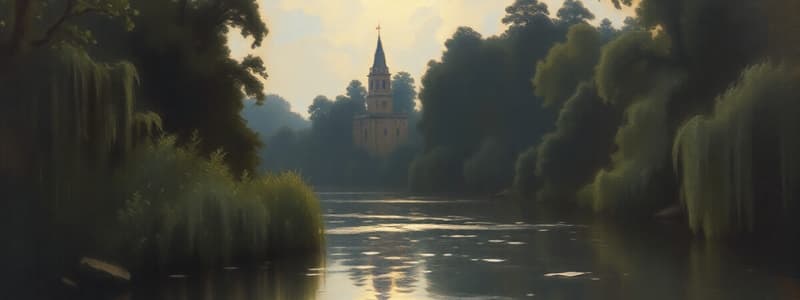Podcast
Questions and Answers
Which of the following is considered the most basic element of art?
Which of the following is considered the most basic element of art?
- Color
- Line (correct)
- Texture
- Shape
What principle of art refers to the feeling of wholeness in a work?
What principle of art refers to the feeling of wholeness in a work?
- Contrast
- Balance
- Unity (correct)
- Emphasis
Which element of art refers to the quality of a surface?
Which element of art refers to the quality of a surface?
- Texture (correct)
- Shape
- Form
- Color
What type of movement is characterized by uneven visual weight in an artwork?
What type of movement is characterized by uneven visual weight in an artwork?
Which principle of art involves the gradual changes in an element?
Which principle of art involves the gradual changes in an element?
In which domain of arts would you categorize sculpture?
In which domain of arts would you categorize sculpture?
What component of color describes its intensity?
What component of color describes its intensity?
Which principle is demonstrated by planned or random repetitions in an artwork?
Which principle is demonstrated by planned or random repetitions in an artwork?
What is sculpture classified as in the context of visual arts?
What is sculpture classified as in the context of visual arts?
Which technique uses light and shadow to create realistic depth in art?
Which technique uses light and shadow to create realistic depth in art?
What is the primary characteristic of two-dimensional art?
What is the primary characteristic of two-dimensional art?
Which of the following is a type of three-dimensional art?
Which of the following is a type of three-dimensional art?
What determines the direction and length of a shadow in perspective drawing?
What determines the direction and length of a shadow in perspective drawing?
Which of the following is NOT considered a form of visual media?
Which of the following is NOT considered a form of visual media?
What does 'mosaic' refer to in visual arts?
What does 'mosaic' refer to in visual arts?
Which form of media is defined as being encoded in a machine-readable format?
Which form of media is defined as being encoded in a machine-readable format?
Flashcards are hidden until you start studying
Study Notes
Elements of Arts
- Building blocks essential for creating artwork.
- Seven key elements define artistic expression.
Seven Elements of Art
- Lines: The most fundamental element.
- Shape: Areas in a two-dimensional space, divided into:
- Geometric: Measurable forms.
- Organic: Complex and difficult to measure.
- Form: Three-dimensional shapes incorporating depth.
- Texture: Surface quality, affecting visual and tactile experiences.
- Space: Designated areas serving specific purposes in artwork.
- Color: Perceived phenomena, includes:
- Hue: The color's name.
- Saturation: Color intensity.
- Value: The lightness or darkness of the color.
- Value: Utilizes light and dark, creating shades and highlights.
Principles of Art
- Unity: Overall wholeness; key goal of artwork.
- Harmony: Blending and balance of elements.
- Contrast: Differences in values, colors, shapes, and textures.
- Gradation: Gradual changes in visual elements.
- Variety: Introduction of slight differences.
- Pattern: Repetitive elements, can be planned or random.
- Repetition: Utilizes the same elements consistently, pairs with pattern.
- Movement: Guides viewers' eyes throughout the artwork.
- Rhythm: Creates an active feel or suggests vibration.
- Balance: Visual weight distribution:
- Symmetric: Equal weight on both sides.
- Asymmetric: Unevenly weighted visuals.
- Radial: Elements radiate from a central point.
- Emphasis: Highlights specific areas to attract attention.
- Proportion: Relationship of parts to each other and to the whole work.
- Simplicity: Use of few similar elements for uniformity.
Steps in Art Criticism
- Description: Identify elements present.
- Analysis: Examine principles used in the piece.
- Interpretation: Engage with the artwork empathetically.
- Evaluation/Judgement: Assess overall success or impact.
Domains of Arts
- Visual Arts: Diverse expressions across cultures and periods.
- Stained Glass, Sculpture, Assemblage, Painting.
- Architecture: Involves buildings and structural design.
- Includes Architectural design, Interior Design, Landscape architecture.
- Media Arts: Relies on technology for expression.
- Encompasses Television, Radio, Magazines, Kiosks.
General Categories of Visual Arts
- Fine Arts: Emphasis on craftsmanship.
- Includes Drawing, Painting, Printmaking, Sculpture.
- Contemporary Arts: Art reflective of modern times.
- Features Assemblage, Installation, Mixed Media.
- Decorative Arts and Crafts: Functional and aesthetic design.
- Incorporates Mosaic Arts, Tapestry, Ceramics, Glass Art.
- Other Applied Arts: Broad definitions within visual arts.
- Examples include Tattoo Art, Interior Design, Body Painting.
Common Types of Visual Arts
- Two-Dimensional Art: Lacks depth, has length and width.
- Includes Painting, Drawing, Printmaking, Collage, Stained Glass, Mosaic.
- Three-Dimensional Art: Occupies space with height, width, and depth.
- Primarily represented by Sculpture and Found Objects.
Different Forms of Media
- Aural Media: Engaged through sound.
- Examples include Radio advertising, Music, CDs, MP3s, Vinyl Records.
- Print Media: Physical media perceived visually.
- Encompasses Newspapers, Magazines, Flyers, Posters.
- Visual Media: Non-printed, yet visually consumed media.
- Includes Television, Cinema, Video games, Documentaries.
- Digital Media: Content in a machine-readable format.
- Covers Websites, Text messages, Kiosks, E-books, Video games.
Drawing Shadows in Perspective
- Light Source: Determines shadow's direction and length.
- Object: The item that creates the shadow.
- Ground Plane: Surface on which the shadow is cast.
Chiaroscuro
- Derived from Italian terms for light (chiaro) and darkness (scuro).
- Technique emphasizes shadows and a light source to create depth and tone.
- Focuses on the interplay between light and darkness.
Parts of a Composition with Chiaroscuro
- Source of Light: Direction from which light emanates.
Studying That Suits You
Use AI to generate personalized quizzes and flashcards to suit your learning preferences.




